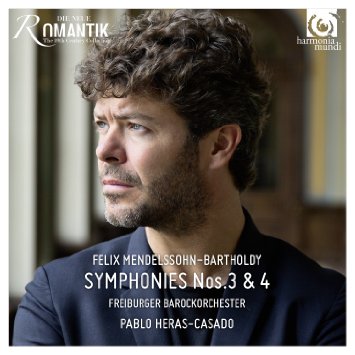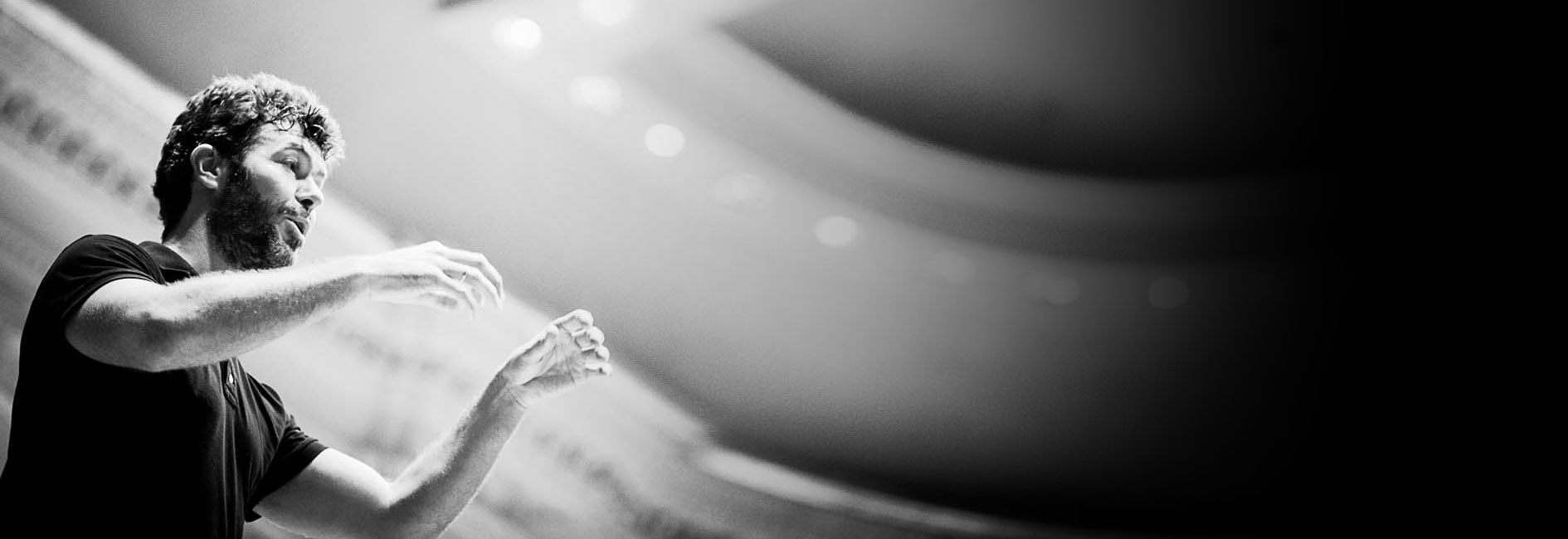
Mendelssohn: Symphonies Nos. 3 & 4
Description
Following his critically acclaimed recording of Mendelssohn’s Symphony No.2, Spanish conductor Pablo Heras-Casado returns with Symphonies Nos. 3 and 4, this time leading the Freiburger Barockorchester. Both works have origins in the composer’s 1829-1831 tour of Europe. Symphony No.3, sometimes called the ”Scottish” symphony, was inspired by a visit to the ruined Holyrood Chapel in Edinburgh in 1829. It was not completed until 1842, making it, chronologically, the last of his five symphonies. Symphony No.4, called the ”Italian” symphony, was born of the color and atmosphere of Italy, and was completed in Berlin in 1833.
Enjoy a video preview from harmonia mundi featuring Pablo Heras-Casado in interview, detailing the background of this exciting project.
Label: Harmonia Mundi
Release date: Jan 22, 2016
*Choc de Classica Award Winner (2016)
*”Preis der deutschen Schallplattenkritik” Award Winner (2016)
*Planet Hugill 2016 CDs of the Year
Reviews:
” ***** – The Freiberger Barockorchester under Pablo Heras-Casado continue their exploration on disc of German Romantic repertoire with two of Mendelssohn’s best loved symphonies, the “Scottish” (No 3) and the “Italian” (No 4). It makes for quite extraordinary listening, the edgy warmth of the period instruments lending probing penetration and utter uniqueness to what we traditionally think of as the accepted Mendelssohn sound. It’s as if the cobwebs and time-honoured nostalgia have been swept aside, leaving the music feeling as fresh as the day it was written. The brazen wind timbres in the opening bars of the “Scottish”, the breezy precision of the strings in the “Italian”, coupled with the fleet-footed, warm-hearted energy of Heras-Casado’s compelling interpretations, and thrill-a-minute playing from the orchestra, make for truly essential listening.”
Ken Walton – The Scotsman
“***** – Conductor Pablo Heras-Casado now takes on Mendelssohn with winning accounts of the two best-known symphonies. The Scottish Symphony, under the wrong baton, can be a sluggish affair but here it is as energised as a spring jaunt in the Highlands.
The opening andante is an invitation unable to be refused; sighing phrases and exquisitely contoured lines are born of the purest Romanticism. Period woodwind, horns and timpani make their presence felt throughout while the finale comes across as a feisty, and discreetly funky, country dance. The Italian Symphony is permeated with a Mediterranean zest for life. The closing saltarello is so light on its feet it seems to dance at twice the speed of some other versions.”
William Dart – NZHerald
“***** – This is young man’s music, Mendelssohn was between 20 and 21 when he made the grand tours and when Symphony No. 3 was finally completed, Mendelssohn was still only 32. The great virtue of these performances from Pablo Heras-Casado and the Freiburg Baroque Orchestra is that by stripping the varnish of these symphonies, they allow us not only to hear timbres closer what Mendelssohn might have done, but they bring out the youthful vigour of the music. These are performances full of dramatic contrasts and romantic ethos, with lots of vivid accents and articulation. Gone is the rather smooth, young-fogey-ish image which the symphonies can sometimes have.
Symphony No. 3, Scottish, opens with the evocative Andante con moto based on themes which Mendelssohn sketched when at Holyrood. A wind dominated chorale is followed by vibrato-less strings, sombre and plangent. This introduces us to the sound-world, with the strings making a firm, yet flexible and quite wiry sound which has a vibrancy to it and an admirable lack of mannerism in the phrasing. The overall sound is far more wind dominated, and the different tang and timbres of the instruments come out. When we reach the Allegro un poco agitato speeds are fast but full of vibrant detail with moments of great excitement and terrific drama. I was rather surprised to be reminded in places of both Berlioz and Dvorak. The second movement, Vivace non troppo is transparently played, but still quite string with fine rhythmic articulation animating the whole. The plangent opening phrase of the Adagio brings out how much Heras-Casado clearly relishes the contrasts between strings and wind. With lovely long breathed phrasing from the strings, we get a great sense of the overall structure too. The final is vibrant, almost perkily so.
Symphony No. 4, Italian opens with a lovely sweep, and a great sense of detail. There is a piquancy to the playing but also a lovely sense of joy. This is playing to put a real smile on your face. As with the Symphony No. 3 it is the rhythmic verve which the players bring to the music which makes the Allegro vivace leap (almost dance) of the page. And the complex coda at the end is a complete joy. The long chorale-like melody of the Andante con moto goes with a long-breathed fluid motion, yet is full of colour. The whole movement is brimful of delicious moments of orchestral texture and colour, yet Pablo Heras-Casado does not linger overmuch and keeps things movement. The third movement, Con moto moderato sweeps along with a gracious elegance with the delicacy in the middle section reminding one of the fairies from A Midsummer Night’s Dream. Finally we have the saltarello of the Presto finale, finely controlled but rhythmically exciting and full of contrasts of drama.
In both works I was able to appreciate some details of scoring which had not been apparent before. But both these symphonies reveal large scale, serious dramatic structures with vibrant detail and a great forward thrust yet never feeling driven. Speeds are not the fasted on disc (John Eliot Gardiner on LSO Live is over two minutes faster for Symphony No. 3), but the verve with which the orchestra places really makes the music swing.”
Robert Hugill – Planet Hugill
“Heras-Casado creates a wonderful flow here and throughout there is the most lovely instrumental tapestry of sound with wonderful shaping of phrases and always with an underlying urgency of flow. There are some most lovely hushed passages . . . This is a performance of chamber like subtlety and transparency with an underlying drive and energy.
Harmonia Mundi has a winner with Pablo Heras-Casado and the Freiburger Barockorchester. If you think that you’ve heard these symphonies too many times try these performances and revel in the freshness of re-discovery.”
Bruce Reader – The Classical Reviewer
“Le jeune chef espagnol Pablo Heras-Casado nous revient en force avec un enregistrement magistral consacré aux Symphonies « Ecossaises » et « Italiennes » de Mendelssohn . . . La Symphonie « italienne » connaît aussi une genèse complexe qui nous renvoie dès l’automne 1830 à Venise lorsque Mendelssohn évoque dans ses lettres la progression de son écriture. Il faudra pourtant attendre le 13 mars 1833 pour la découvrir à Hanover Square Rooms, toujours sous la direction de l’auteur. Captivé dans les Highlands par les atmosphères mystérieuses des mythes et légendes, c’est le caractère plus joyeux, pétillant et ensoleillé d’Italie qui anime Mendelssohn dans son écriture.
Magnifier le langage de ces symphonies n’est pas chose aisée. D’abord par l’opulence des détails, contrastes, idées et dynamiques, mais surtout par une interprétation qui pourrait vite tomber dans la facilité d’un romantisme exubérant. A la tête d’une très belle phalange – écoutez la clarté et la brillance des vents accompagnés d’un tapis de cordes enjoué et soigné -, Pablo Heras-Casado démontre qu’il a toutes les clés en main pour réussir. Il adopte sans difficulté des nuances idéales, du plus petit pianissimo aux grands tutti massifs. Ajoutez à cela un sens de l’orientation et des phrases acquis, vous obtenez du très beau Mendelssohn. Il faut dire que le chef bénéficie ici d’un orchestre irréprochable dont la technique instrumentale, sur instruments d’époque, efface toutes les difficultés. Belle distinction entre passages nerveux et passages discrets avec une conception des atmosphères aboutie. Heras-Casado donne ici une vision moderne de deux chefs-d’œuvres du répertoire aux allures tantôt lyriques, tantôt pétillantes. Une lecture en soi d’un chef épanoui, alerte au moindre détail et qui unifie le matériau de manière magistrale . . .”
Ayrton Desimpelaere – Crescendo Magazine
“Mendelssohn es un compositor desvirtuado por prejuicios. Su apariencia como epígono del clasicismo esconde un interior complejo y subjetivo. Hoy se lo ve como el heredero de Beethoven, por delante de Brahms o Wagner. Pablo Heras-Casado (Granada, 1977) ha desarrollado una afinidad natural hacia su música. Lo demostró en 2014 con su Segunda sinfonía, Lobgesang, al frente de la Orquesta de la Radio Bávara (Harmonia Mundi).
Ahora revela la esencia pos-schubertiana y prewagneriana de la Tercera y la Cuarta, las llamadas Escocesa e Italiana. Versiones bruñidas por el dinamismo y el dramatismo, pero dirigiendo a la Orquesta Barroca de Friburgo con instrumentos de época. Una integral sinfónica de referencia en proceso.”



